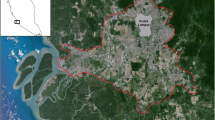Abstract
The effect of urban development on butterfly species' richness and species' incidence is tested for the Greater Manchester conurbation and two sample areas, mapped at finer scales, within the southern part of the conurbation. The tests include measures of bias for recording effort (number of visits). Species' richness is found to increase with percentage urban cover for Greater Manchester (tetrad scale) and decrease with urban cover for the two sample areas in South West Manchester (1 km scale) and the Mersey Valley (100 m scale). For Greater Manchester, the increase in species' richness with increased urban cover is largely explained by lower species' richness at higher altitude in the Pennines bounding the conurbation. For the two sample areas, decreasing species' richness associated with increasing urban cover corresponds with reductions in the areas of a number of semi-natural habitats, hostplants and nectar sources. Despite these statistically significant correlations, the impact of urban cover on species' richness is weak. The maximum loss rate identified anywhere within the region is 0.81 species per 10% change in urban cover for South West Manchester. This finding may reflect on the generally low species diversity of the region. However, these results could be influenced by recording and sampling artefacts, particularly the failure of mapping programmes to distinguish vagrant individuals from breeding populations and a bias of records to vagrants. This is supported by the higher correlations between species' incidence and nectar sources than between species' incidence and their hostplants. Adult butterflies are opportunistic nectar users and nectar sources are more widely spread and thus less influenced by urban development than are specific butterfly hostplants. The finding may also reflect on the capacity of most of the butterfly species to breed successfully on tiny areas of hostplant existing within extensively built-up areas. Moreover, the capacity of butterfly species to persist by using small fragments of hostplants would be enhanced by vagrancy. If this is indeed the case, it is a finding that would support the value of small patches in butterfly metapopulations, albeit ones comprising incomplete complements of resources required during the life cycle. The incidence of most species decreases with increase in urban cover. Multivariate analyses indicate that this is owing to corresponding declines in hostplant-habitats and nectar sources. Five species increase with urban cover, but none attain formal significance. Associations among hostplants and habitat variables in a principal components analysis suggest that, in three cases (Pieris brassicae, P. rapae, Celastrina argiolus), this is owing to increasing areas of their hostplants within urban environments.
Similar content being viewed by others
References
Asher J (1995) Butterfly net. Butterfly Conservation News 60: 15
Baker RR (1979) The evolution of the migratory habit in butterflies. Journal of Animal Ecology 38: 703–746
Dennis RLH (1993) Butterflies and Climate Change. Manchester University Press, Manchester
Dennis RLH and Bardell P (1996) The impact of extreme weather on Great Orme populations of Hipparchia semele (Linnaeus 1758) and Plebejus argus (Linnaeus 1758) (Papilionoidea: Satyrinae and Lycaenidae): hindsight, inference and lost opportunities. Entomologist's Gazette, 47: 211–225
Dennis RLH and Hardy PB (1999) Targeting squares for survey: predicting species richness and incidence of species for a butterfly atlas. Global Ecology & Biogeography Letters (in press)
Dennis RLH and Shreeve TG (1996) Butterflies on British and Irish Offshore Islands: Ecology and Biogeography. Gem Publishing, Wallingford, UK
Dennis RLH and Williams WR (1986) Butterfly 'diversity'. Regressing and a little latitude. Antenna 10:108–112
Dennis RLH, Sparks TH and Hardy PB (1999) Bias in butterfly distribution maps: the effects of sampling effort. Journal of Insect Conservation 3: 33–42
Dover JW (1991) The conservation of insects on arable farmland. In: Collins NM and Thomas JA (eds) The Conservation of Insects and their Habitats, pp 294–318. Academic Press, London
Forman RTT (1995) Land Mosaics. Cambridge University Press, Cambridge
Garland SP (1981) Butterflies of the Sheffield area. Sorby Natural History Society and Sheffield City Museums, Sheffield
Hardy PB (1998) Butterflies of Greater Manchester. PGL Enterprises, Sale, UK
Hardy PB and Dennis RLH (1997) Butterfly range-extension into Greater Manchester: the role of climate change and habitat patches. Urban Nature Magazine 3: 6–8
Hardy PB, Hind S and Dennis RLH (1993) Range extension and distribution-infilling among selected butterfly species in north-west England. Evidence for inter-habitat movements. Entomologist's Gazette, 44: 247–255
Harrison S and Taylor AD (1997) Empirical evidence for metapopulation dynamics. In: Hanski IA and Gilpin ME (eds) Metapopulation Biology. Ecology, Genetics and Evolution, pp 27–42. Academic Press, London
Heath J, Pollard E and Thomas JA (1984) Atlas of Butterflies in Britain and Ireland. Viking, London
New TR (1997) Butterfly conservation (2nd ed). Oxford University Press, Oxford
Owen DF (1949) The Macrolepidoptera of the Moorgate, London, bombed sites. Entomologist 82: 59–62
Owen DF (1951) Bombed site Lepidoptera. Entomologist 84: 265–272
Plant C (1987) The Butterflies of the London Area. Passmore Edwards Museum, London
Shreeve TG, Dennis RLH and Williams WR (1996) Uniformity of wing spotting of Maniola jurtina (L.) (Lepidoptera: Satyrinae) in relation to environmental heterogeneity. Nota Lepidopterologica 18: 77–92
Sokal RR and Rohlf FJ (1995) Biometry. W.H. Freeman, New York
Statistica (1994) Statistica for Windows. Statsoft Inc, Tulsa, USA
Warren MS (1992) Butterfly populations. In: Dennis RLH (ed) The Ecology of Butterflies in Britain. Oxford University Press, Oxford
Warren MS (1993) A review of butterfly conservation in central south Britain. Biological Conservation 64: 25–35
Author information
Authors and Affiliations
Rights and permissions
About this article
Cite this article
Hardy, P.B., Dennis, R.L. The impact of urban development on butterflies within a city region. Biodiversity and Conservation 8, 1261–1279 (1999). https://doi.org/10.1023/A:1008984905413
Issue Date:
DOI: https://doi.org/10.1023/A:1008984905413




